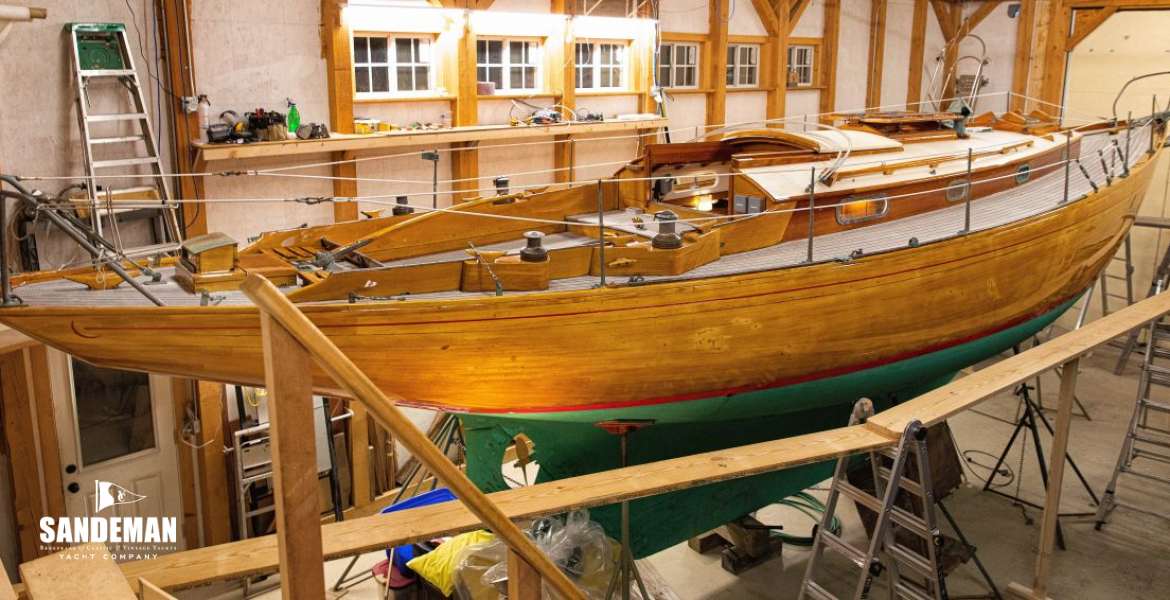
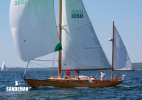
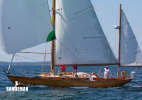
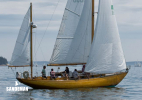
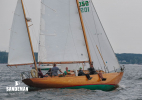
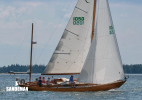
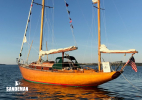

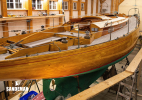
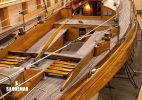
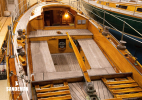


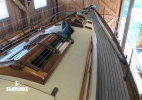
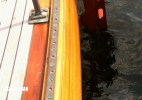
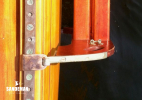

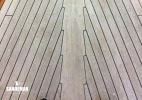
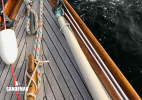
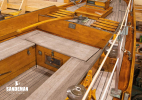
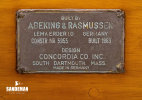
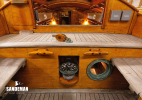
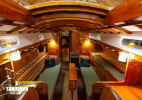
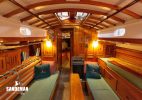

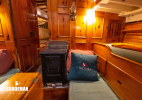
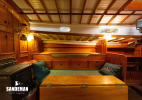
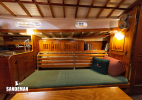
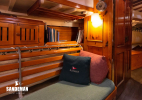
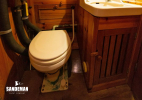
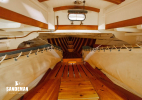
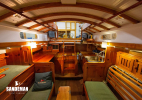
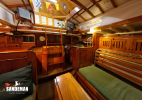
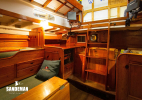
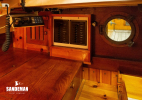
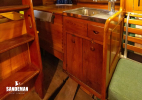
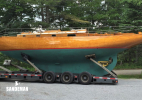
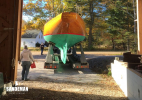
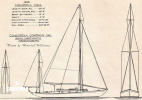

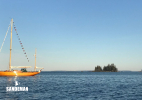
| Designer | Ray Hunt & Waldo Howland |
|---|---|
| Builder | Abeking & Rasmussen |
| Date | 1963 |
| Length overall | 41 ft 0 in / 12.5 m |
| Length deck | 41 ft 0 in / 12.5 m |
| Length waterline | 28 ft 6 in / 8.69 m |
|---|---|
| Beam | 10 ft 3 in / 3.12 m |
| Draft | 5 ft 8 in / 1.73 m |
| Displacement | 9 Tonnes |
| Construction | Mahogany and Douglas fir on angelique and oak |
| Engine | Yanmar Diesel 3HM35F 30hp |
|---|---|
| Location | USA |
| Price | Sold |
These details are provisional and may be amended
In contributing to the class’s fiftieth year anniversary book in 1988, one owner wrote:
“… how many times in life do you get to own something as beautiful as a Concordia yawl!” KATRINA offers a unique opportunity to own one of these legendary Ray Hunt-designed fast cruiser-racers, extra specially cared for all her life by just two owning families. It is easy to understand a Concordia’s appeal: looks; ease of use; part of a great story - the classic yacht as time machine, yet fully functional art. KATRINA is all of this, and more ready than most for continuing stylish sailing adventures.
Interested in KATRINA in more detail.
KATRINA's sweetly preserved state did not occur via a fluke of nature or simple good luck. It is directly attributable to an enviable set of circumstances: superior genetic origins (thanks to her legendary designers and builders) coupled with an increasingly rare case of multi-generational family TLC.
In return for the 55 years of uninterrupted care my mother’s family has devoted to this work of functional art, KATRINA has more than upheld her end of the deal. She appears to be as vibrant at 57 as she was when my grandfather, Hans Rozendaal, took possession of her in 1965.
Like her sister Concordias, KATRINA possesses an apparent simplicity that masks her revolutionary design - design that delivers a functionality that stands the test of time and relieves us of the burden to need to understand exactly how something works before we can experience the joy of using it. It’s all the things you don’t see that deliver these vessels their rare elegance.
As we have transitioned KATRINA from one generation to the next she has shown few signs of weakness or weariness. Having been treated to a magnificent centerline rebuild at Benjamin River Boat Yard 20 years ago, then cared for by the capable craftsmen at the Brooklin Boatyard, she is now being cared for by a pair of wonderfully talented owners at Kallisté Yacht Services in Lincolnville, Maine.
Our family feels extraordinarily honored to have KATRINA gracing our lives, and trust that she feels similarly!
2013 - Present
Kallisté Yacht Services, Maine
- Annual winter maintenance
2017-2018
Kallisté Yacht Services, Maine
-Removal and re-bedding of all stanchions
2016 - 2017
Kallisté Yacht Services, Maine
- Stripping of original canvas from trunk cabin roof
- Local repairs to original strip Douglas fir roof
- Sheathed with Dynel and painted with Awlgrip
2015 - 2016
Kallisté Yacht Services, Maine
- Localised oak frame replacement in forward sections
1998 - 1999
Benjamin River Marine, Maine
- Major Centerline Rebuild of keel, floors and frames by Benjamin River Marine/ Doug Hyland & John Dunbar,
Doug Hyland wrote:
“As is the case with almost all of the Concordia Yawls, Katrina was built with iron floor & keel bolts. After thirty five years, the iron bolts in KATRINA’s bilges were starting to be a concern, especially considering her owner’s desire to enter her in some off-shore races. The surveyor seconded this concern and as a result KATRINA was scheduled for a centerline rebuild during the winter of 98-99.
“The object of the process [was] to replace the deteriorated iron bolts with bronze, but unfortunately these bolts are not easy to get at. First the rudder, ballast keel and deadwood must be removed in order to expose the bottom ends of the old iron bolts. Next, a fair amount of the interior (at least the head compartment and engine) must be removed to get at the top ends of some of the bolts. It is usually deemed advisable to strengthen the mast step area at the same time and this requires more of the fo’c’sle and head area joinery to be removed. Then the offending bolts are knocked out and replaced with bronze bolts.
“If life were simple, the above would pretty well describe a centerline rebuild. But, as you might expect, after some four decades of service there can be some complications and it would be penny-wise and pound-foolish not to deal with these problems while the boat is opened up. The first suspect is the wooden keel. Our experience with BELLE’s (sistership) showed us that Concordia keels appear to be made of the same wood as the planking (African mahogany or Khaya) and that they are subject to the same problem that often afflicts the planking. The wood does not really rot, but becomes ‘shelly’, seeming to come unglued along the annual growth rings. Sure enough this process was well underway on KATRINA.
“Concordia keels were designed back when old growth timber was still readily available - such large timbers (about 22 feet long, 24 inches wide and 6 inches thick, all outside the heart, or pith of the tree) are now extremely difficult to locate. Luckily we found a suitable piece of Angelique in Central America. To complicate matters further, these boats are planked in such a way that a substantial amount of the bottom planking (7 or 8 planks per side) must be removed in order to uncover the entire keel for removal.
“With her bottom opened up and a new keel jacked into place it was time to tend to some of KATRINA’s other problems. Many of her laminated frame ends were de-laminated and had to be repaired or replaced. We also replaced all the floor timbers that were connected to the keel.
Forward in the mast step area these floors were made of galvanized iron so that they could be shallower to preserve headroom in this part of the boat. These were replaced with welded bronze floors with a new laminated wood and bronze mast step on top. 316 Stainless steel tie-rods with bronze turnbuckles were installed to connect the chainplates to the metal floors; further aft the wooden floor timbers were replaced as well.
“We decided to use vertical grain Douglas fir to replace the bottom planking. Fir is about the same weight and strength as the African mahogany and is not subject to the shelling problem that affects most mahoganies. At the same time the remainder of the under-water planking was refinished and her bottom smoothed up to give her every chance on the race course. While Concordia yawls do suffer from some chronic structural problems, their overall excellence of design and surpassing beauty make them well worth the expense of this kind of work. Boats like this are truly irreplaceable and we are fortunate to have people like KATRINA’s owners who are willing to make a commitment to preserve them for the future. With her newly built bottom there is no reason she should not continue to sail for generations to come.”
Concordia Number: 94
Abeking & Rasmussen build no. 5955
Born from the devastating hurricane of 1938, initially simply as a replacement for Concordia yard owner Llewellyn Howland’s destroyed earlier yacht, through a combination of excellent marketing and the choice of a superb builder in Abeking & Rasmussen for 100 of the 104 built to this sweet Ray Hunt and Waldo Howland design - through the 1950s and 60s the Concordia Yawls quickly became, and have remained, legendary as one of the most successful series-produced wooden cruiser-racer classes.
Oil industry heir Frederic R Pratt (his grandfather Charles Pratt was a pioneer of the US petroleum industry) became the 94th Concordia Yawl owner in 1963 when WHISPER, as she was first known, was delivered from Bremen. She is one of the Concordia 41s, a variant developed early on by Hunt and Howland to further enhance their success on the race course, having slightly more displacement and a lower centre of gravity of the keel - and therefore more sail carrying capability.
Pratt would get to enjoy this beautiful yacht from its Glen Cove, New York moorings but briefly, dying from a heart attack at the age of 58 in 1966. Remarkably she has subsequently been under the stewardship of one family through three generations.
The present owners’ grandparents, Dr. Hans and Kay Rozendaal, renamed her KATRINA after their daughter. The Rozendaals were adventurous sailors – perhaps reflecting Hendrick’s Second World War service in the US Army Medical Corps in North Africa, Italy and Germany, and later as a volunteer in a civilian hospital in Vietnam. They had crossed the Atlantic in 1960 with their previous KATRINA, a Sparkman & Stephens “Loki” yawl.
In this Concordia KATRINA they made five more Atlantic crossings, cruising extensively in European and North Atlantic waters and participating in such occasions as the 250th anniversary of the Royal Cork Yacht Club in 1969 and in the activities of the Cruising Club of America, of which club Hans was a long-term member and, for some years, Fleet Surgeon.
After Hans’s passing in 1992, the family moved KATRINA “Down East” from her long term base at Mystic Connecticut to Maine. A major structural refit at Benjamin River Boatyard 1998-1999 dealt with the elements of her structure that had naturally timed-out after 35 years of extensive sea miles. She has continued to be cherished as the family cruiser-racer (including a class win at the Eggemoggin Reach Regatta) and maintained in love and detail during careful undercover winter storage.
KATRINA is a special one in already very special company.
- Mahogany carvel topsides planking
- Mahogany, and Douglas fir (1999), bottom planking
- Laminated white oak frames (many repaired 1999-2017)
- Oak and bronze floors
- Bronze tie rods chainplates to keel
- Bronze hanging knees
- Angelique wood keel (1999)
- Teak laid deck
- Mahogany deck structures
- Trunk cabin roof Dynel sheathed (2017) over original Douglas fir planks
FROM AFT
- All deck carpentry mahogany and locust
- Varnished, flush with hull sides uncapped toe rail
- Faired out aft to taffrail
- Bronze pushpit with mizzen sheet lead
- Bronze stanchions
- Bronze pulpit
- Teak laid deck
- Bronze mooring fairleads port and starboard
- Padeye for mizzen sheet
- Bronze pushpit with mizzen sheet lead
- Large single wood mooring cleat at aft deck
- Lazarette hatch/ ventilated gas locker
- Slatted deck seats to port and starboard of mizzen mast and bronze rudder head
- Wood tiller
- Raised cockpit coaming bronze capped
- Lower than deck level raw teak cockpit seats; stowage under
- Engine panel at aft cockpit bulkhead
- 2 x Winch plinths port and starboard with wood cleats
- Bronze Sheet Winches:
- 2 x Lewmar 48 primary: 2-speed self-tailing
- 2 x Lewmar 40 secondary: 2-speed non-self-tailing
- Compass in alcove under bridge deck
- Mainsheet padeye on bridge deck with cleats port and starboard
- Instrument repeaters aft starboard cabin trunk bulkhead
- Single boom gallows socket to port
- Bronze headsail tracks and cars on toerail port and starboard
- Mahogany cabin trunk sides with 4 x bronze ports port and starboard
- Further opening port forward cabin trunk
- Grabrails on coachroof port and starboard
- Butterfly skylight over saloon
- Bronze Dorade box and cowl ventilator &
- Bronze “Charlie Noble” ventilator fwd of skylight
- Main mast position
- Bronze staysail boom traveller
- Forward trunk cabin 2 x outboard hinged leaves butterfly hatch
- 2 x circular port lights in butterfly hatch
- Foredeck with large wooden cleat and bronze cleat
- CQR bower anchor stowed in bronze offset to starboard launching shoe
- 55lb Luke Yachtsman anchor
- 6ft/ 1.8m 5/16in/ 8mm chain; 200ft / 60m rode
- 25ft/ 8m 5/8 in chain; 250ft/ 76m rode
- 20lb Danforth anchor
FROM COMPANIONWAY, DOWN 5 x STEPS FWD OF ENGINE BOX
- Softwood carpentry
- Raw teak sole
- White painted deckhead with bright finished beams to coachroof
GALLEY areas to port and starboard
- Stowage over engine box
- Work surface and stainless steel sink to port
- Manual fresh water pump
- Stowage under, outboard and under bridge deck
- Large insulated stainless steel ice box
- Plotter display on swing out bracket
- Shaded “reading” lamp
Hinged chart table/ work surface area to starboard
- Origo 3000 alcohol/ spirit 2 x burner hob under
- Stowage under, outboard and under bridge deck
- VHF Radio
- Ship’s electrical panel
- Radar display on swing out bracket
- Shaded reading lamp
- Round bronze opening port to cockpit
Semi bulkheads forward to saloon
SALOON
- Settees port and starboard
- Through passage offset to port
- Pilot berth to starboard
- Stowage under and at fwd bulkhead
- Concordia Company solid fuel stove at fwd starboard bulkhead
- Concordia pattern “Pullman” bronze and timber slatted seatback to port
- Stowage lockers and shelf outboard; bookshelf alcove fwd
- 2 x Long grabrails at coachroof deckhead
- Oak drop leaf table
- 2 x Shaded reading lamps
- 1 x Oil lamp
Passage forward to heads and forecabin
HEADS compartment to port
- Wilcox & Crittenden Skipper II marine toilet
- Stowage lockers outboard
- Plumbed for holding tank or overboard discharge
- Ceramic sink basin
- Manual fresh water pump
- Stowage lockers under and outboard
Drawers, hanger space and stowage area to starboard
FORECABIN
- 2 x Fold galvanized tube fold down cots
- Stowage under
- Holding tank to port
SPARS, RIG
- All masts and spars varnished Sitka spruce
- Radome on mizzen strut
- 1 x 19 stainless steel wire standing rigging with bronze turnbuckles
- Profurl roller furling headstay
- Sitka spruce spinnaker pole stowed at starboard fwd toerail
Bronze halyard winches
- 2 x Lewmar 16, single-speed self-tailing
- 2 x Lewmar 16, two-speed self-tailing
- 1 x Reefing winch at main boom
SAILS by Doyle (1999)
- Mainsail
- Mizzen
- Mizzen staysail
- Tri-radial spinnaker
- No. 1 Genoa
- No. 2 Genoa
- No. 3 Genoa
CANVASWORK
- Hatch covers
- Companionway dodger (sprayhood)
- Sail covers for main & mizzen
MECHANICAL
- Yanmar 3HM35F Diesel engine: 35hp
- Hurth KBW10 2.47:1 transmission
- 1 1/8 in/ 29mm bronze shaft
- Last Drop packless gland stuffing box
- AccuTech bronze 2-bladed 12x18 RH propeller
- Water cooled hose exhaust with Vernay composite water lift
- Muffler
- Basic Yanmar ignition panel
- Separate gauges for engine temperature and oil pressure
- Alarms: Low oil pressure & high engine temperature
- Bus type warm air heater
ELECTRICAL
- 12V DC and 120V DC
- 3 x Group 27 AGM Batteries
TANKAGE
- Copper fuel tank: 28 Gal/ 105 L
- Racor fuel filter
- 2 x Fresh water tanks under saloon settees: c55 Gal/ 208 L Total
- Oceanlink holding tank: 20 Gal/ 76 L
- Ritchie Helm Compass
- Raymarine ST60 Apparent Wind Speed & Direction
- Raymarine Tridata, Depth, Speed and Log
- Raymarine C70 GPS Chartplotter on companionway swing-out bracket
- Raytheon RL9 / Radar on companionway swing-out bracket
- Uniden MC690 VHF Radio
- Chelsea Ship's Clock
- Chelsea Barometer
- 3 x Portable fire extinguishers
- 2 x Hanging radar reflectors
- Lifesling
- Horseshoe life ring
- Personal floatation devices
- Aerosol type air horn
- Rule 2000 submersible electric bilge pump
- Manual bilge pump in cockpit
- Bilge alarm
- Boarding ladder
- Dock lines and fenders
- Varnished shroud rollers
- Cockpit cushions
- Varnished wood boat hook
- Telescopic aluminium boat hook
- Ensign staff
- Magma Grill
- John Williams
- Ladleah Dunn
- Anthony M. Theriault
Contact us to discuss KATRINA in more detail.
These particulars have been prepared from information provided by the vendors and are intended as a general guide. The purchaser should confirm details of concern to them by survey or engineers inspection. The purchaser should also ensure that the purchase contract properly reflects their concerns and specifies details on which they wish to rely.